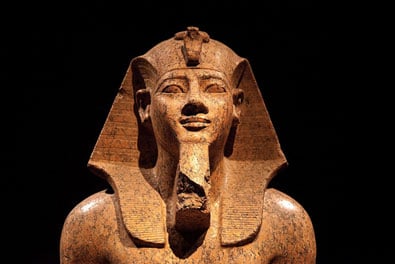
Researchers find Long-lost Mummy of Chief Steward to Amenhotep II
Academics have solved a centuries-old puzzle by tracking down the mummy of Qenamun, chief steward of pharaoh Amenhotep II (c 1427 – 1400 BC), in a former monastery, according to a report in Discovery News. Qenamun grew up alongside Amenhotep II and their bond endured into adult life, with Qenamun enjoying elite status despite not having royal blood himself.
Amenhotep II was the 7 th Pharaoh of Egypt’s 18 th Dynasty and is believed to have been Tutankhamun’s great-great grandfather. Amenhotep II (sometimes read as Amenophis II and meaning Amun is Satisfied) inherited a vast kingdom from his father Thutmose III, and held it by means of a few military campaigns in Syria; however, he fought much less than his father, and his reign saw the effective cessation of hostilities between Egypt and Mitanni, the major kingdoms vying for power in Syria.

Statue of Amenhotep II. Credit: Gabriele D’Arrigo
Qenamun was raised alongside Amenhotep II because his mother, Amenemipet, was the chief royal nurse of the future king. Although Qenamun’s beautifully decorated tomb was located in Thebes, his remains were missing and his whereabouts have been a mystery ever since.
"Identifying Qenamun has been like fitting together long-lost puzzle pieces," Marilina Betrò, professor of Egyptology at Pisa University, told Discovery News.

This detail illustration of a painting in Qenamun's tomb shows Qenamun's mother Amenemipet holding in his lap the future pharaoh Amenhotep II. ATLAS DE L'HISTOIRE DE 'ART EGYPTIEN DI PRISSE D'AVENNES, PARIS 1868-78
The quest to track down the remains of Qenamun began two years ago when a skeleton resting in a cardboard box was found in a store room of a 14th-century monastery located in Calci, a village near Pisa in Italy. The skull bore an inscription stating that it was one of the mummies brought from Egypt by Europe’s first Egyptology professor, Ippolito Rosellini. According to historical records, Rosellini wrote a letter in 1829 to Grand Duke Leopold II outlining a list of 1,878 antiquities he had brought back to Italy. The list included the description of 11 mummies.
One of the mummies had been described as resting in a black varnished coffin with yellow painted hieroglyphs. Anthropological analysis indicated the skeleton belonged to a rather tall male (5’ 9") who died around 30 years of age. The bone remains do not show any sign of disease but the head of one of the remains' femurs is enlarged and stretched, a peculiarity observed in those who regularly rode in bumpy and speedy chariots.
Meanwhile, parallel research in Florence's Egyptian museum revealed the presence of a black varnished coffin with yellow painted hieroglyphs which previous researches attributed as coming from Rosellini's expedition. At careful examination, the yellow painted hieroglyphs revealed the name of the coffin's owner as the God's Father Qenamun.
"The very important title confirmed it belonged to Amenhotep II's foster brother," Betrò said.
Finally re-united, the skeleton and his coffin are now on display at an exhibition in Calci Charterhouse.
Featured image: The rediscovered skeleton shows blackened signs of mummification. Credit: Rossella Lorenzi















